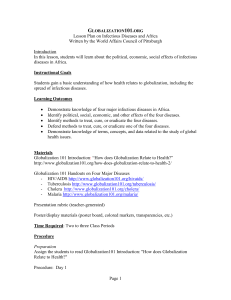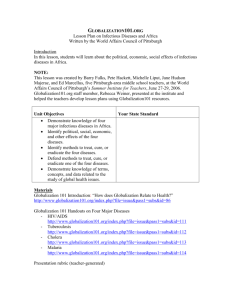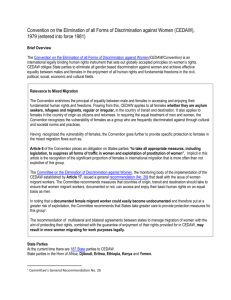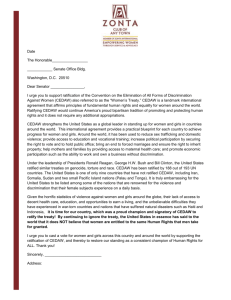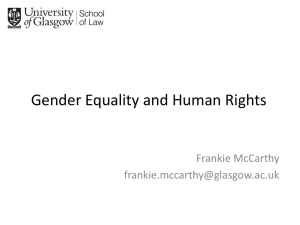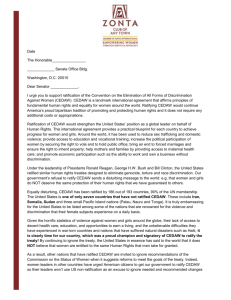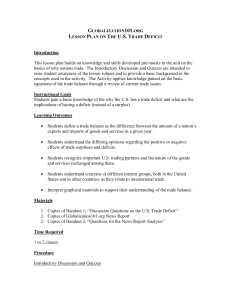UNIT ON WOMEN and GLOBALIZATION
advertisement
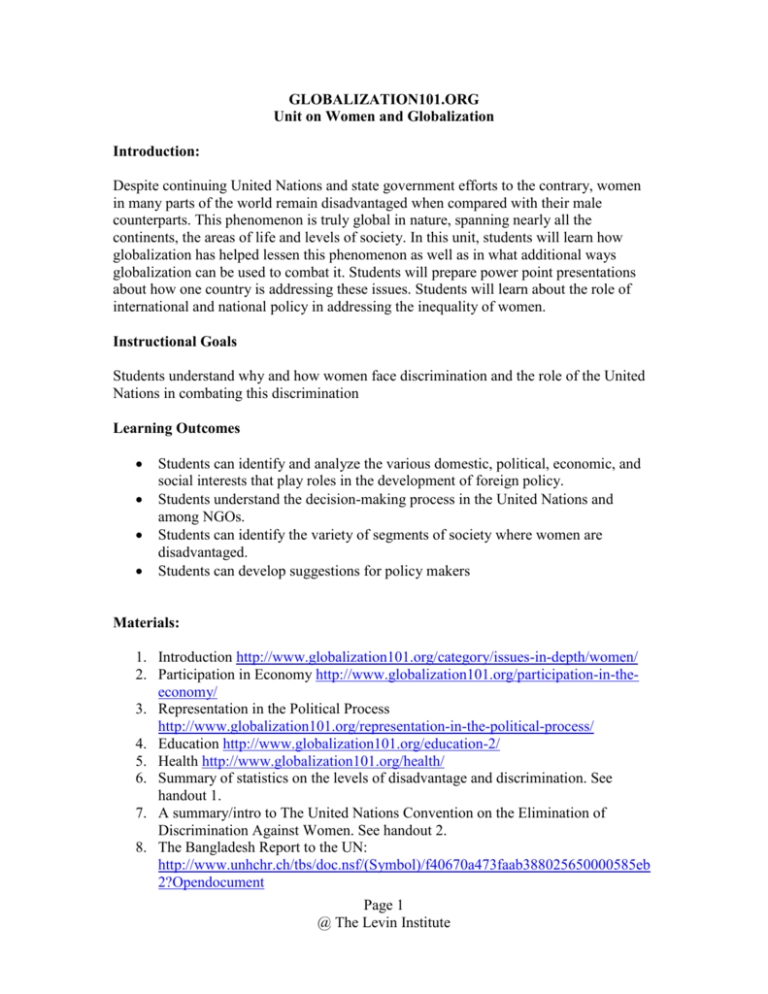
GLOBALIZATION101.ORG Unit on Women and Globalization Introduction: Despite continuing United Nations and state government efforts to the contrary, women in many parts of the world remain disadvantaged when compared with their male counterparts. This phenomenon is truly global in nature, spanning nearly all the continents, the areas of life and levels of society. In this unit, students will learn how globalization has helped lessen this phenomenon as well as in what additional ways globalization can be used to combat it. Students will prepare power point presentations about how one country is addressing these issues. Students will learn about the role of international and national policy in addressing the inequality of women. Instructional Goals Students understand why and how women face discrimination and the role of the United Nations in combating this discrimination Learning Outcomes Students can identify and analyze the various domestic, political, economic, and social interests that play roles in the development of foreign policy. Students understand the decision-making process in the United Nations and among NGOs. Students can identify the variety of segments of society where women are disadvantaged. Students can develop suggestions for policy makers Materials: 1. Introduction http://www.globalization101.org/category/issues-in-depth/women/ 2. Participation in Economy http://www.globalization101.org/participation-in-theeconomy/ 3. Representation in the Political Process http://www.globalization101.org/representation-in-the-political-process/ 4. Education http://www.globalization101.org/education-2/ 5. Health http://www.globalization101.org/health/ 6. Summary of statistics on the levels of disadvantage and discrimination. See handout 1. 7. A summary/intro to The United Nations Convention on the Elimination of Discrimination Against Women. See handout 2. 8. The Bangladesh Report to the UN: http://www.unhchr.ch/tbs/doc.nsf/(Symbol)/f40670a473faab388025650000585eb 2?Opendocument Page 1 @ The Levin Institute 9. The Bangladesh Shadow report: http://www1.umn.edu/humanrts/iwraw/shadow/bangladeshreport.htm Time Period: 2-3 Classes (excluding research time) Procedure: Preparation Before Class Before class, have students read: The introduction http://www.globalization101.org/category/issues-indepth/women/ Participation in economy section http://www.globalization101.org/participation-in-the-economy/ Representation in the political process http://www.globalization101.org/representation-in-the-political-process/ Education http://www.globalization101.org/education-2/ Health http://www.globalization101.org/health/ This will set the background for class discussion. First Class 1. Read Handout 1: Disadvantages and Discrimination to the class. Ask the students if they are surprised by any of the statistics and if so which ones and why. 2. Review the readings from Globalization101.org. Ask the students what surprised them. What role does culture play in the institutional discrimination against women? What problems do the students view as most pressing (education, health, politics,)? With limited budgets, where should developing countries place the most money? Which problems should be addressed first and why? 3. Distribute Handout 2 What is CEDAW? Have the students read it and answer any questions the students might have. 4. Divide the class into groups. Give half the groups, the Bangladesh Report to the UN: http://www.unhchr.ch/tbs/doc.nsf/(Symbol)/f40670a473faab388025650000585eb 2?Opendocument. Have the groups read the report and prepare a power-point presentation highlighting Bangladesh’s achievements in fulfilling the guidelines set out by CEDAW. 5. Give the other groups, the Bangladesh Shadow report: http://iwraw.igc.org/shadow/bangladeshreport.htm. Have the groups read the report and prepare a power-point presentation highlighting the sections in which the official report was insufficient. Page 2 @ The Levin Institute (Allow the students adequate time to prepare the power-point presentations) Second class 1. Have the groups present their power-point presentations to the class 2. Talk about how these reports may be similar or different. Why this is the case. Whether these differences are society-wide, nation-specific, global, etc. Can nongovernmental organizations and the government able to work together to solve the problem? Do they seem to be working together now? 6. Ask whether globalization (and the stretch of international business) can fix this problem or adds to the dilemma. 7. Have students think about what kinds of policies would help alleviate this problem Page 3 @ The Levin Institute Handout 1: Disadvantages and Discrimination The United Nations estimates that: 1. 58 million primary-school-aged girls worldwide are not enrolled in school 2. In only 14 countries in the world women hold one-third of the seats in the nation’s legislature, or equivalent body a. What are those countries? South Africa, Mozambique, Finland, Sweden, Denmark, Iceland, Netherlands, Germany, Rwanda, Argentina, Costa Rica, France, Pakistan and India. 3. More than two-thirds of the world’s births occur outside of health facilities or without skilled obstetric care1. a. 500,000 women die in pregnancy and childbirth every year b. An African woman faces a 1 in 16 chance of dying in childbirth, while in the industrialized world, that chance is 1 in 2800. 4. Suffrage: a. In 1893, New Zealand became the first nation to grant women full voting rights b. Countries that followed: United States (1920), Albania (1920), Mongolia (1924), Ecuador (1929), Turkey (1930), Sri Lanka (1931) c. Countries that have only granted suffrage recently: Switzerland (1971), Iraq (1980), Namibia (1989), South Africa-black population (1994). d. Some countries still do not allow women to vote, including: Brunei, Darussalem, Kuwait, Sultanate of Oman, Saudi Arabia, United Arab Emirates2. 5. Convention on the Elimination of All Forms of Discrimination Against Women (CEDAW) (as of May 2009): a. Iran, Nauru, Palau, Tonga, Somalia, Sudan, Nieu, Vatican City, the United States of America have either not signed or not ratified CEDAW b. 80 ratifications, accessions and successions to CEDAW. “The Promotion of Gender Equality and Empowerment of Women”. www.refugeesinternational.org/content/article/detail/6527. 12 October 2005 2 “Online Women: Statistics, Online Women in Politics”. www.onlinewomeninpolitics.org/statistics.htm. 12 October 2005. 1 Page 4 @ The Levin Institute Handout 2: What is CEDAW? *The Convention on the Elimination of All Forms of Discrimination Against Women is an international treaty on women’s rights adopted by the United Nations in 1979. *The main idea of CEDAW is simple: women should have equal rights with men in every aspect of their lives. *Considered to be a veritable “Bill of Rights” for women, the Convention’s 30 articles define what is to be considered discimination against women and how nations can combat such discrimation. *The Convention defines discrimination against women as “...any distinction, exclusion or restriction made on the basis of sex which has the effect or purpose of impairing or nullifying the recognition, enjoyment or exercise by women, irrespective of their marital status, on a basis of equality of men and women, of human rights and fundamental freedoms in the political, economic, social, cultural, civil or any other field”3. *CEDAW discusses many different areas in which governments should be working toward achieving women’s equal rights, public and political life, education, employment, maternal rights, *CEDAW affects every woman because it promises that she should be treated fairly and without discrimination in all the things she does. *By signing the Convention, each country is committing itself to amending its laws and practices to guarantee women equal rights and opportunies as well as remedies. The state is also committing itself to presenting a report every four years (at most) that details their progress and setbacks in continuing to amend their national practices. “Convention on the Elimination of All Forms of Discrimination Against Women”. http://www.un.org/womenwatch/daw/cedaw/ . 12 October 2005. 3 Page 5 @ The Levin Institute

